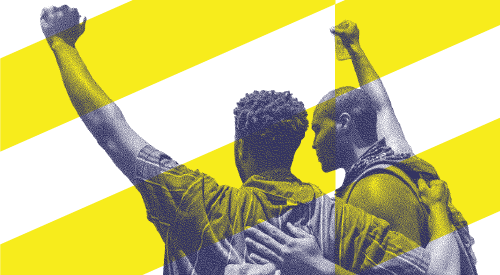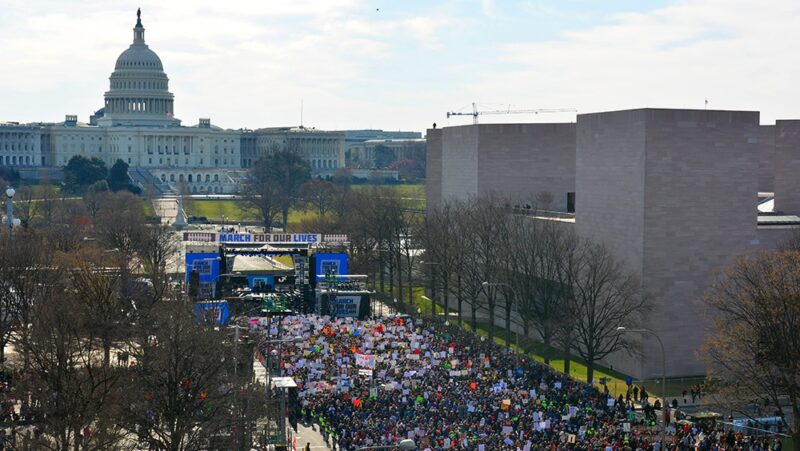Freedom of Assembly
What is freedom of assembly under the First Amendment?
The freedom to assemble protects the right of people to peacefully gather on any subject and, if they wish, to protest for or against government policies and practices.
How does freedom of assembly protect our rights?
Freedom of assembly prevents the government from restricting public protests because officials disagree with a group’s viewpoint, find a group’s message offensive, or don’t like the way a group conducts its protest.
Courts have said it also protects meetings, discussion and planning that leads to a protest or demonstration – sometimes called the “right of association,” though those words are not in the First Amendment.
The right to assemble is closely linked to another freedom: petition. Both protect the public’s right to demand change in how government operates.
Assembly is the only freedom among the five in the First Amendment that can’t be exercised alone.
As U.S. Supreme Court Justice Robert Jackson often said during his time on the court in the 1940s and ’50s, assembly “protects the right to differ.”
Can freedom of assembly be limited?
Violent assembly is not protected. The government can arrest protesters engaging in illegal acts (like vandalism, theft, assault) or where a speaker says things that are intended to and likely to “incite imminent lawless action.”
Some time, place and manner restrictions on public protest may be imposed. But those limits must be grounded in neutral reasons such as public safety or undue traffic congestion. They cannot be applied based on the viewpoint or message of the people assembling. For example, “buffer zones” around polling places or clinics where abortions are performed have been approved by the courts. But the size of those zones must balance any concerns with allowing protestors to get their message across.
The First Amendment protects us from government limits or control on the right to assemble. But with a few exceptions, it does not protect people from private employers, which generally can discipline or fire people for joining groups and protesting. However, private employers may not limit employees from labor organizing, union activities and organizing to oppose harassment or discrimination in the workplace.
Some states have extended protections for private employees regarding assembly (and other First Amendment freedoms). Most commonly, those laws are focused on preventing private employers from punishing employees for political activity outside the workplace.
Public employees also have more limited rights of assembly (along with more limits on free speech) when their actions negatively affect government operations.
Explore our freedom of assembly article library

How has freedom of assembly been used?
Americans have prized the right of public protest throughout the nation’s history. Assemblies have protested slavery and certain taxes. Demonstrations have involved union organizing, calls for increased safety laws and anti-war protests.
The modern Civil Rights Movement’s sit-ins, boycotts and marches effectively touched a nation’s conscience, prompting the passing of voting rights and anti-discrimination laws. In recent years, people have rallied and taken to the streets on many sides of issues as diverse as abortion, gun control and LGBTQ+ rights.
Freedom of assembly protects everyone, even those whose messages are seen as unpopular or hateful. In 1977, state and federal courts upheld the right of a neo-Nazi group to march through Skokie, Illinois, a heavily Jewish suburb of Chicago where many Holocaust survivors lived.
Freedom of assembly also protects our rights from indirect government action to limit them. For example, the government cannot impose an unfair fee or unreasonable requirements to try to stifle a group’s message. In 1992, in Forsyth County v. Nationalist Movement, the Supreme Court voided a local law that allowed officials to charge higher permit fees if marches might need a higher level of police protection. The justices said the law was too vague. It improperly allowed local officials to base the fee on their personal view of the protest’s message.
How have freedom of assembly protections changed over time?
The nation’s founders saw the right to assemble and to publicly protest as essential in protecting all other rights. Protests had been vital in raising objections to English law in the colonial period and later in raising support for independence.
Early court rulings established that lawful assemblies were not limited to challenging government policies. Rather, discussions on religious, economic, social, political and other topics are protected.
In 1937, the Supreme Court declared in De Jonge v. Oregon that the “the right to peaceable assembly is a right (equal) to those of free speech and free press and is equally fundamental.”
In 1945, the Supreme Court said in Thomas v. Collins that assembly protected the right of “workmen or of unions … businessmen, farmers, educators, political party members or others to assemble and discuss their affairs and to enlist the support of others.”
In National Association for the Advancement of Colored People v. Patterson, a unanimous Supreme Court said in 1958 that the NAACP had the right, by freedom of association, not to disclose its membership lists. A disclosure law was viewed as a state attempt to intimidate people and discourage them from joining the civil rights group.
The right of assembly now is considered well-established and intertwined with the freedoms of speech, the press and petition. There has not been a Supreme Court ruling directly on this right for more than 30 years.
Many states have passed new laws on how, when and to what extent public protests may be conducted. Critics say many laws are too vague, too restrictive or intended to discourage public demonstrations and assemblies. Whether such laws violate the First Amendment freedom of assembly would be up to a court to consider if challenged.
Explore the Freedom of Assembly
$30,000 Giving Challenge
Support the Freedom Forum’s First Amendment mission by Dec 31st and double your impact.
Latest articles
You might also be interested in


